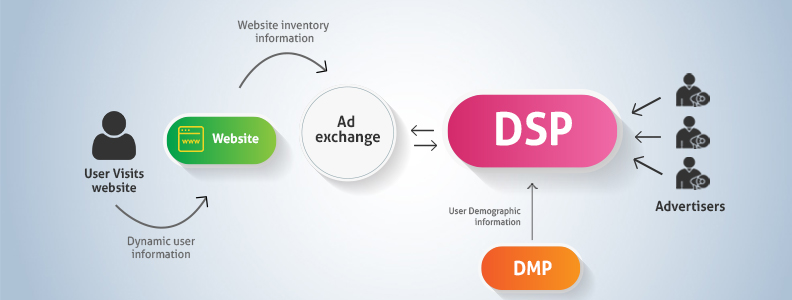Demystifying RTB: A Deep Dive into Real-Time Bidding Mechanics
The real-time bidding process, a cornerstone of modern advertising exchanges, often evokes a sense of intrigue and curiosity. Websites say that DSP and SSP platforms are crucial for everyone in advertising.

To grasp their importance, you need to explore how real-time bidding works and how different platforms use it. But to truly understand the significance of these platforms, one must delve into the intricate workings of real-time bidding and unravel the nuanced ways in which different platforms harness their power at its core, real-time bidding (RTB) is a dynamic auction system that unfolds in the blink of an eye whenever a user loads a webpage or accesses a digital platform.
Exploring the RTB meaning adds a layer of insight into the dynamics of the advertising ecosystem. This process is designed to facilitate the buying and selling of ad impressions instantaneously, creating a highly responsive and efficient marketplace. The question then arises: how does this seemingly complex mechanism serve the interests of advertisers, publishers, and users alike?
1. Auction Process
a. User Engagement Journey: A user initiates a digital experience by visiting a website or using a mobile app.
b. Publisher Decision: The website or app owner, referred to as the publisher, makes decisions to improve the user experience and maximize revenue. One such decision involves selling ad space on their platform, setting a series of digital transactions in motion.
c. Ad Request Process: Following the user's interaction, the publisher's website or app sends an ad request to an Ad Exchange or SSP (Supply-Side Platform, publisher's platform). This request includes information about the user, the content they are viewing, and other relevant data, creating a comprehensive profile for potential advertisers.
d. Auction Initiation: Upon receiving the ad request, Ad Exchanges, or SSPs, initiate an auction to sell the available ad space. Multiple advertisers can participate in the auction, each vying for the opportunity to display their ad content.
e. Bid Responses: Using their DSPs (demand-side platforms, advertiser's platforms), advertisers quickly submit bid responses. These responses include bid amounts, creative details, and targeting information, providing a basis for the ad exchange or SSP to evaluate and make decisions.
f. Auction Outcome: The ad exchange, or SSP, assesses all bid responses and determines the highest bidder, who secures the right to display their ad. This outcome is the result of a swift evaluation process that considers factors like bid amount, creative quality, and adherence to targeting criteria.
g. Ad Display: The winning ad is promptly displayed on the user's device after the auction. This final step in the process seamlessly integrates the selected content into the user's digital experience.
2. Role of Demand-Side Platforms (DSPs)
a. Bid Optimization: Demand-side platforms (DSPs) play a pivotal role in optimizing bids for advertisers. Operating in real-time, DSPs sift through vast datasets, analyzing user behavior, historical performance metrics, and advertiser goals. This meticulous analysis informs bid optimization strategies, ensuring that advertisers achieve the best possible outcomes in the highly competitive world of real-time bidding.

b. Audience Targeting: One of the key functionalities of DSPs lies in their ability to facilitate precise audience targeting. Advertisers leverage DSPs to define specific audience segments based on various parameters, such as demographics, interests, and online behavior. This granular approach ensures that ads are strategically displayed to the most relevant users, enhancing the likelihood of engagement and conversion.
c. Budget Management: DSPs empower advertisers with robust tools for effective budget management. Advertisers set budgets and bidding strategies within the DSP interface, allowing them to exert control over campaign spending. The dynamic nature of digital advertising requires flexibility, and DSPs excel in managing budgets efficiently, ensuring that ad campaigns achieve maximum impact without exceeding predefined financial constraints.
d. Real-Time Reporting: In the fast-paced world of digital advertising, real-time insights are invaluable. DSPs provide advertisers with comprehensive real-time reporting and analytics capabilities. This feature allows advertisers to monitor the performance of their campaigns on the fly. By gaining immediate visibility into key metrics such as impressions, clicks, and conversion rates, advertisers can make informed decisions and swiftly adjust their strategies to optimize campaign outcomes.
e. Predictive Analytics: Beyond real-time reporting, DSPs often incorporate predictive analytics into their repertoire. DSPs can provide advertisers with insights into future trends and potential opportunities by analyzing historical data and user behavior patterns. This forward-looking approach enables advertisers to proactively refine their targeting strategies, ensuring that campaigns remain adaptive and responsive to evolving market dynamics.

f. Integration with Data Management Platforms (DMPs): DSPs often seamlessly integrate with data management platforms (DMPs) to enhance audience targeting capabilities. DMPs provide a centralized repository for managing and analyzing data, enabling advertisers to harness rich audience insights. The synergy between DSPs and DMPs allows advertisers to create highly targeted and personalized campaigns, leveraging a wealth of data to optimize ad delivery and maximize impact.
3. Role of Supply-Side Platforms (SSPs)
a. Ad inventory management: Within the intricate framework of digital advertising, supply-side platforms (SSPs) emerge as essential facilitators, specializing in the efficient management and sale of publishers' ad inventory. SSPs offer publishers a suite of tools designed for ad inventory management and selling, allowing them to set pricing floors and establish rules for selling ad spaces. This functionality provides publishers with a high degree of control over the monetization of their digital real estate.
b. Auction Facilitation: SSPs act as intermediaries in the intricate dance of real-time bidding, serving as connectors between publishers, multiple demand-side platforms (DSPs), and ad exchanges. By facilitating the auction process, SSPs create a dynamic marketplace where publishers can maximize the visibility and value of their ad inventory. This interconnected ecosystem ensures that publishers gain access to a diverse pool of potential buyers, fostering healthy competition for their ad spaces.
c. Yield Optimization: At the heart of SSP functionality lies the mission to optimize yields for publishers. Leveraging sophisticated algorithms, SSPs analyze various factors, including user demographics, device types, and historical data. To strategically maximize revenue from the sale of ad impressions. This holistic approach enables publishers to extract the highest value from their digital assets, aligning with the ever-changing dynamics of the digital advertising landscape.

d. Dynamic Pricing Strategies: SSPs empower publishers with dynamic pricing strategies, allowing them to adapt to the fluctuating demands of the market. By incorporating real-time data insights, SSPs enable publishers to adjust pricing dynamically, responding to shifts in user behavior, market trends, and advertiser demand. This flexibility ensures that publishers can strike a balance between competitive pricing and revenue optimization, creating a win-win scenario in the digital advertising arena.
e. Real-Time Analytics: In the pursuit of transparency and performance optimization, SSPs furnish publishers with real-time analytics tools. These tools provide publishers with instantaneous insights into the performance of their ad inventory. Offering a detailed breakdown of impressions, clicks, and revenue generated. Real-time analytics empower publishers to make data-driven decisions, fine-tuning their strategies on the fly to capitalize on emerging opportunities and mitigate potential challenges.
f. Ad Quality Control: SSPs play a crucial role in upholding the quality of ad inventory. By implementing stringent screening processes, SSPs ensure that only high-quality and relevant ads are presented to users. This commitment to ad quality not only enhances the user experience but also preserves the integrity of the publishers' digital environments, fostering trust among users, advertisers, and publishers alike.
g. Collaboration with Data Partners: SSPs often collaborate with data partners to enhance audience insights and targeting capabilities for publishers. By integrating data-driven solutions. SSPs empower publishers to deliver more personalized and targeted ad experiences, catering to the diverse preferences and behaviors of their audiences.
4. Algorithmic Ad Placements
a. Predictive Algorithms: Algorithms within DSPs use predictive modeling to assess the likelihood of user engagement with an ad.

b. Dynamic Decision-Making: These algorithms make rapid decisions in milliseconds based on various factors, including bid amounts, user data, and campaign goals.
c. Machine Learning: Machine learning is often incorporated to enhance bid optimization and targeting capabilities over time.
d. Ad Creative Selection: Algorithms help in selecting the most suitable ad creative for a particular user, increasing the likelihood of engagement.
To sum it up
Real-time bidding (RTB) stands as a sophisticated and data-driven process that orchestrates a harmonious interplay among multiple stakeholders, including publishers, advertisers, Demand-Side Platforms (DSPs), and Supply-Side Platforms (SSPs). This dynamic ecosystem, fueled by the speed and efficiency inherent in RTB, revolutionizes the way digital advertising is conducted, enabling advertisers to seamlessly connect with their target audience while delivering relevant and highly targeted ad experiences.




